A Research on Driving Factors of Carbon Emissions of Road Transportation Industry in Six Asia-Pacific Countries Based on the LMDI Decomposition Method
Abstract
1. Introduction
2. Research Method
2.1. Expansion of Kaya Identity
2.2. The LMDI Decomposition Method Based on Extended Kaya Identity
3. Description of Variables and Data
3.1. Decomposed Variables and Their Database Sources
3.2. Decomposition Variables and Their Data Sources
3.2.1. Economic Output
3.2.2. Transportation Intensity
3.2.3. Energy Intensity
3.2.4. Population Size
3.2.5. Carbon Emissions Coefficient
4. Results and Discussions
4.1. Analysis on Total Carbon Emissions
4.2. Analysis on Main Driving Effect
4.2.1. Economic Output Effect
4.2.2. Transportation Intensity Effect
4.2.3. Energy Intensity Effect
4.2.4. Carbon Emissions Coefficient Effect
4.2.5. Population Size Effect
5. Conclusions and Suggestions
5.1. Conclusions
5.2. Policy Suggestions
Author Contributions
Funding
Acknowledgments
Conflicts of Interest
Appendix A
References
- Grossman, G.M.; Krueger, A.B. Environmental impacts of a north American free trade agreement. Soc. Sci. Electron. Pub. 1991, 8, 223–250. [Google Scholar]
- Kuznets, P.; Simon, P. Economic growth and income inequality. Am. Econ. Rev. 1955, 45, 1–28. [Google Scholar]
- Panayotou, T. Empirical Tests and Policy Analysis of Environmental Degradation at Different Stages of Economic Development; ILO Working Papers; International Labour Office: Geneva, Switzerland, 1993; p. 238. [Google Scholar]
- Kwon, T.H. Decomposition of factors determining the trend of CO2 emissions from car travel in Great Britain (1970–2000). Ecol. Econ. 2005, 53, 261–275. [Google Scholar] [CrossRef]
- Abdallah, K.B.; Belloumi, M.; Wolf, D.D. Indicators for sustainable energy development: A multivariate cointegration and causality analysis from Tunisian road transport sector. Renew. Sustain. Energy Rev. 2013, 25, 34–43. [Google Scholar] [CrossRef]
- Kharbach, M.; Chfadi, T. CO2 Emissions in Moroccan Road Transport sector: Divisia, Cointegration, and EKC analyses. Sustain. Cities Soc. 2017, 35, 396–401. [Google Scholar] [CrossRef]
- Alshehry, A.S.; Belloumi, M. Study of the environmental Kuznets curve for transport carbon dioxide emissions in Saudi Arabia. Renew. Sustain. Energy Rev. 2017, 75, 1339–1347. [Google Scholar] [CrossRef]
- Azlina, A.A.; Law, S.H.; Nik Mustapha, N.H. Dynamic linkages among transport energy consumption, income and CO2 emission in Malaysia. Energy Policy 2014, 73, 598–606. [Google Scholar] [CrossRef]
- Huang, W.M.; Lee, G.W.M.; Wu, C.C. GHG emissions, GDP growth and the Kyoto Protocol: A revisit of Environmental Kuznets Curve hypothesis. Energy Policy 2008, 36, 239–247. [Google Scholar] [CrossRef]
- Lu, I.J.; Lin, S.J.; Lewis, C. Decomposition and decoupling effects of carbon dioxide emission from highway transportation in Taiwan, Germany, Japan and South Korea. Energy Policy 2007, 35, 3226–3235. [Google Scholar] [CrossRef]
- Tapio, P. Towards a theory of decoupling: Degrees of decoupling in the EU and the case of road traffic in Finland between 1970 and 2001. Transp. Policy 2005, 12, 137–151. [Google Scholar] [CrossRef]
- Sorrell, S.; Lehtonen, M.; Stapleton, L.; Pujol, J.; Champion, T. Decoupling of road freight energy use from economic growth in the United Kingdom. Energy Policy 2012, 41, 84–97. [Google Scholar] [CrossRef]
- Kveiborg, O.; Fosgerau, M. Decomposing the decoupling of Danish road freight traffic growth and economic growth. Transp. Policy 2007, 14, 39–48. [Google Scholar] [CrossRef]
- Hankinson, G.A.; Rhys, J.M.N. Electricity consumption, electricity and industrial structure. Energy Econ. 1983, 5, 146–152. [Google Scholar] [CrossRef]
- Reitler, W.; Rudolph, M.; Schaefer, M. Analysis of the factors influencing energy consumption in industry: A revised method. Energy Econ. 1987, 9, 145–148. [Google Scholar] [CrossRef]
- Howarth, R.B.; Richard, B. Energy use in U.S. manufacturing: The impacts of the energy shocks on sectoral output, industry structure, and energy intensity. J. Energy Dev. 1991, 14, 175–191. [Google Scholar]
- Howarth, R.B.; Schipper, L. Manufacturing energy use in eight OECD countries: Trends through 1988. Energy J. 1992, 12, 15–40. [Google Scholar] [CrossRef]
- Park, S.H. Decomposition of industrial energy consumption. Energy Econ. 1992, 13, 265–270. [Google Scholar] [CrossRef]
- Park, S.H.; Dissmann, B.; Nam, K.Y.A. Cross-country decomposition analysis of manufacturing energy consumption. Energy 1993, 18, 843–858. [Google Scholar] [CrossRef]
- Lin, J.; Zhou, N.; Levine, M.; Fridley, D. Taking out 1 billion ton of CO2: The magic of China’s 11th five-year plan. Energy Policy 2008, 36, 954–970. [Google Scholar] [CrossRef][Green Version]
- Sobrino, N.; Monzon, A. The impact of the economic crisis and policy actions on GHG emissions from road transport in Spain. Energy Policy 2014, 74, 486–498. [Google Scholar] [CrossRef]
- Ang, B.W.; Zhang, F.Q.; Choi, K.H. Factorizing Changes in Energy and Environmental Indicators through Decomposition. Energy 1998, 23, 489–495. [Google Scholar] [CrossRef]
- M’raihi, R.; Mraihi, T.; Harizi, R.; Bouzidi, M.T. Carbon emissions growth and road freight: Analysis of the influencing factors in Tunisia. Transp. Policy 2015, 42, 121–129. [Google Scholar] [CrossRef]
- Timilsina, G.R.; Shrestha, A. Factors affecting transport sector CO2 emissions growth in Latin American and Caribbean countries: An LMDI decomposition analysis. Int. J. Energ. Res. 2009, 33, 396–414. [Google Scholar] [CrossRef]
- Liu, N.; Ang, B. Factors shaping aggregate energy intensity trend for industry: Energy intensity versus product mix. Energy Econ. 2007, 29, 609–635. [Google Scholar] [CrossRef]
- Paul, S.; Bhattacharya, R.N. Causality between energy consumption and economic growth in India: A note on conflicting results. Energy Econ. 2004, 26, 977–983. [Google Scholar] [CrossRef]
- Lise, W. Decomposition of CO2 emissions over 1980–2003 in Turkey. Energy Policy 2006, 34, 1841–1852. [Google Scholar] [CrossRef]
- Wei, Q.; Zhao, S.; Xiao, W.A. Quantitative Analysis of Carbon Emissions Reduction Ability of Transportation Structure Optimization in China. J. Transp. Syst. Energy Inf. Technol. 2013, 13, 10–17. [Google Scholar]
- Wang, T.; Lin, B. Fuel consumption in road transport: A comparative study of China and OECD countries. J. Clean. Prod. 2019, 206, 156–170. [Google Scholar] [CrossRef]
- Liimatainen, H.; Arvidsson, N.; Hovi, I.B.; Jensen, T.C.; Nykänen, L.; Kallionpää, E. Road freight energy efficiency and CO2 emissions in the Nordic countries. Res. Transp. Bus. Manag. 2014, 2, 11–19. [Google Scholar] [CrossRef]
- McKinnon, A.; Woodburn, A. Logistical restructuring and road freight traffic growth: An empirical assessment. Transportation 1996, 23, 141–161. [Google Scholar] [CrossRef]
- Puliafito, S.E.; Allende, D.; Pinto, S.; Castesana, P. High resolution inventory of GHG emissions of the road transport sector in Argentina. Atmos. Environ. 2014, 101, 303–311. [Google Scholar] [CrossRef]
- Melo, P.C. Driving down road transport CO2 emissions in Scotland. Int. J. Sustain. Transp. 2016, 10, 906–916. [Google Scholar] [CrossRef]
- Hasan, M.A.; Frame, D.J.; Chapman, R.; Archie, K.M. Emissions from the road transport sector of New Zealand: Key drivers and challenges. Environ. Sci. Pollut. Res. 2019, 23, 23937–23957. [Google Scholar] [CrossRef] [PubMed]
- Sundo, M.B.; Vergel, K.N.; Sigua, R.G.; Regidor, J.R.F. Methods of estimating energy demand and CO2 emissions for inter-regional road transport. Int. J. GEOMATE 2016, 11, 2182–2187. [Google Scholar] [CrossRef]
- Kaya, Y. Impact of Carbon Dioxide Emission Control on GNP Growth: Interpretation of Proposed Scenarios; IPCC Energy and Industry Subgroup, Response Strategies Working Group: Paris, France, 1990. [Google Scholar]
- Jie, Y.U.; Da, Y.B.; OuYang, B. Analysis of Carbon Emission Changes in China’s Transportation Industry Based on LMDI Decomposition Method. China J. Highw. Transp. 2015, 28, 112–119. [Google Scholar]
- Liang, D.P.; Liu, T.S.; Li, Y.J. Comparative study of BRICS’ CO2 emission cost and its influential factors based on LMDI model. Resour. Sci. 2015, 37, 2319–2329. [Google Scholar]
- Scholl, L.; Schipper, L.; Kiang, N. CO2 Emissions from Passenger Transport: A Comparison of International Tends from 1973 to 1992. Energy Policy 1996, 24, 17–30. [Google Scholar] [CrossRef]
- Greening, L.A.; Ting, M.; Davis, W.B. Decomposition of aggregate carbon intensity for freight: Trends from 10 OECD countries for the period 1971–1993. Energy Econ. 1999, 21, 331–361. [Google Scholar] [CrossRef]
- Ang, B.W. Decomposition analysis for policymaking in energy: Which is the preferred method. Energy Policy 2004, 32, 1131–1139. [Google Scholar] [CrossRef]
- Wang, W.W.; Zhang, M.; Zhou, M. Using LMDI method to analyze transport sector CO2 emissions in China. Energy 2011, 36, 5909–5915. [Google Scholar] [CrossRef]
- Intergovernmental Panel on Climate Change (IPCC). IPCC Guidelines for National Greenhouse Gas Inventories 2006 Volume 2 Energy; Intergovernmental Panel on Climate Change: Kanagawa, Japan, April 2007; ISBN 4-88788-032-4. [Google Scholar]
- IEA Sankey Diagram. Available online: https://www.ipcc.ch/data/ (accessed on 3 May 2019).
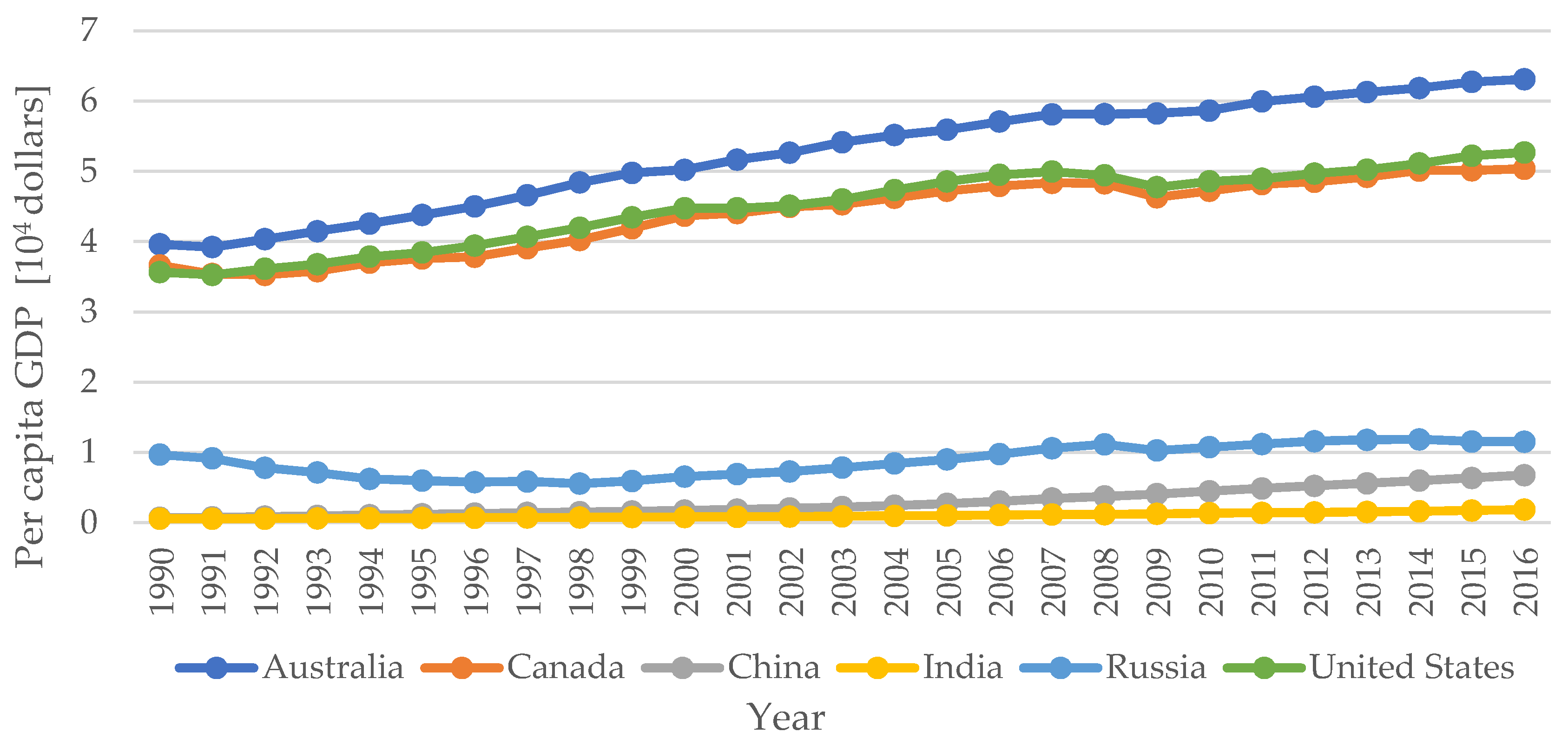
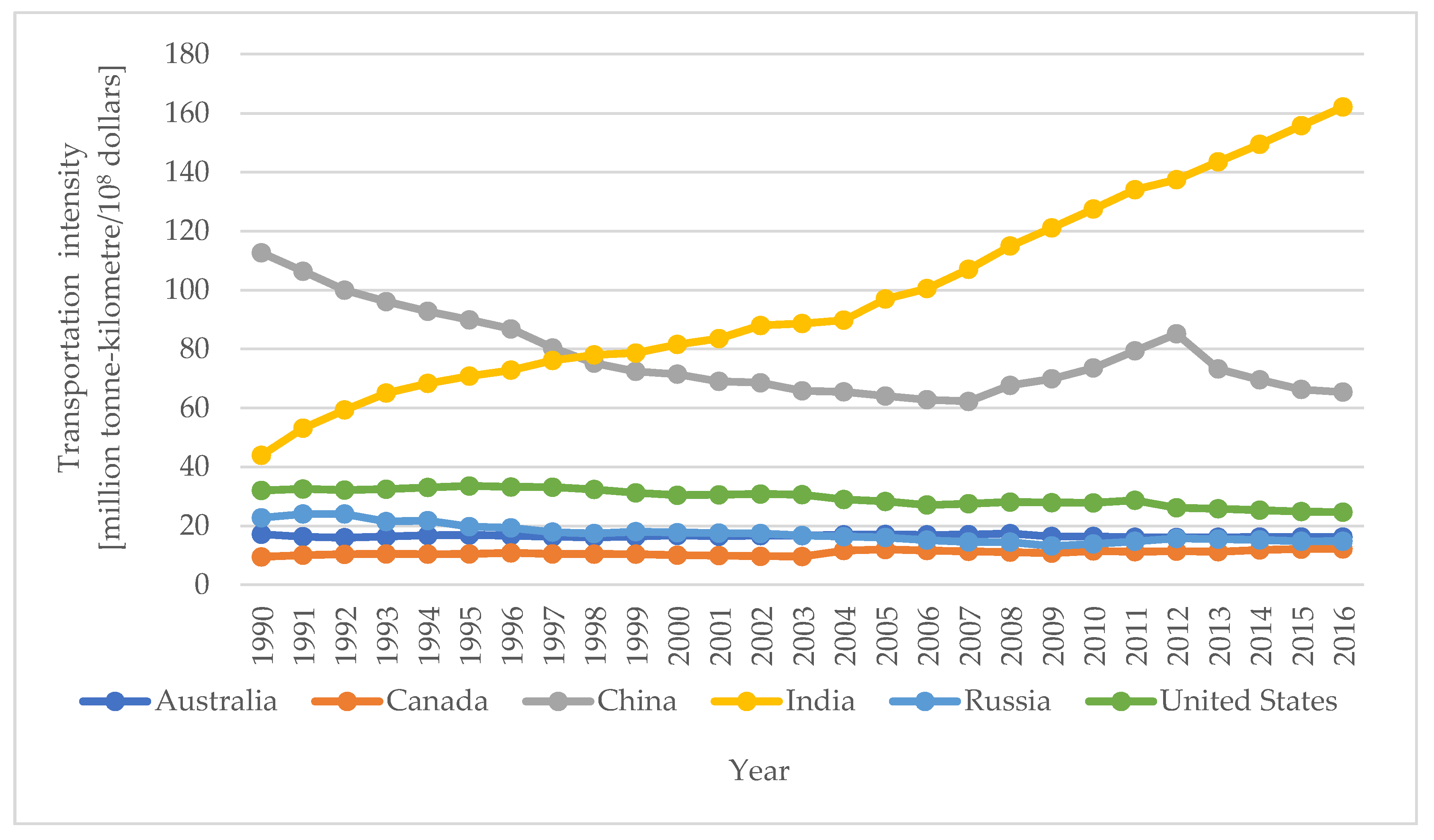
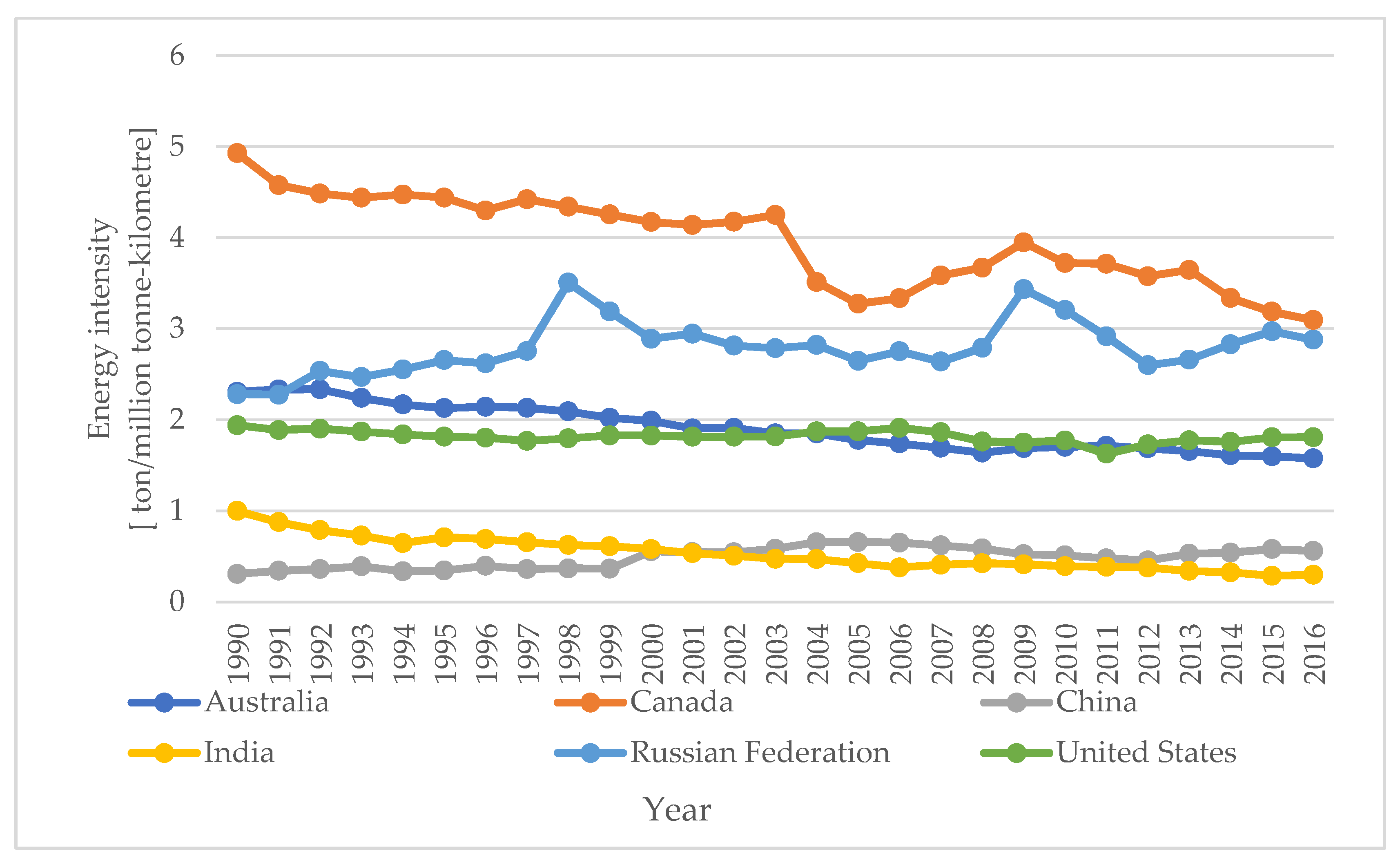
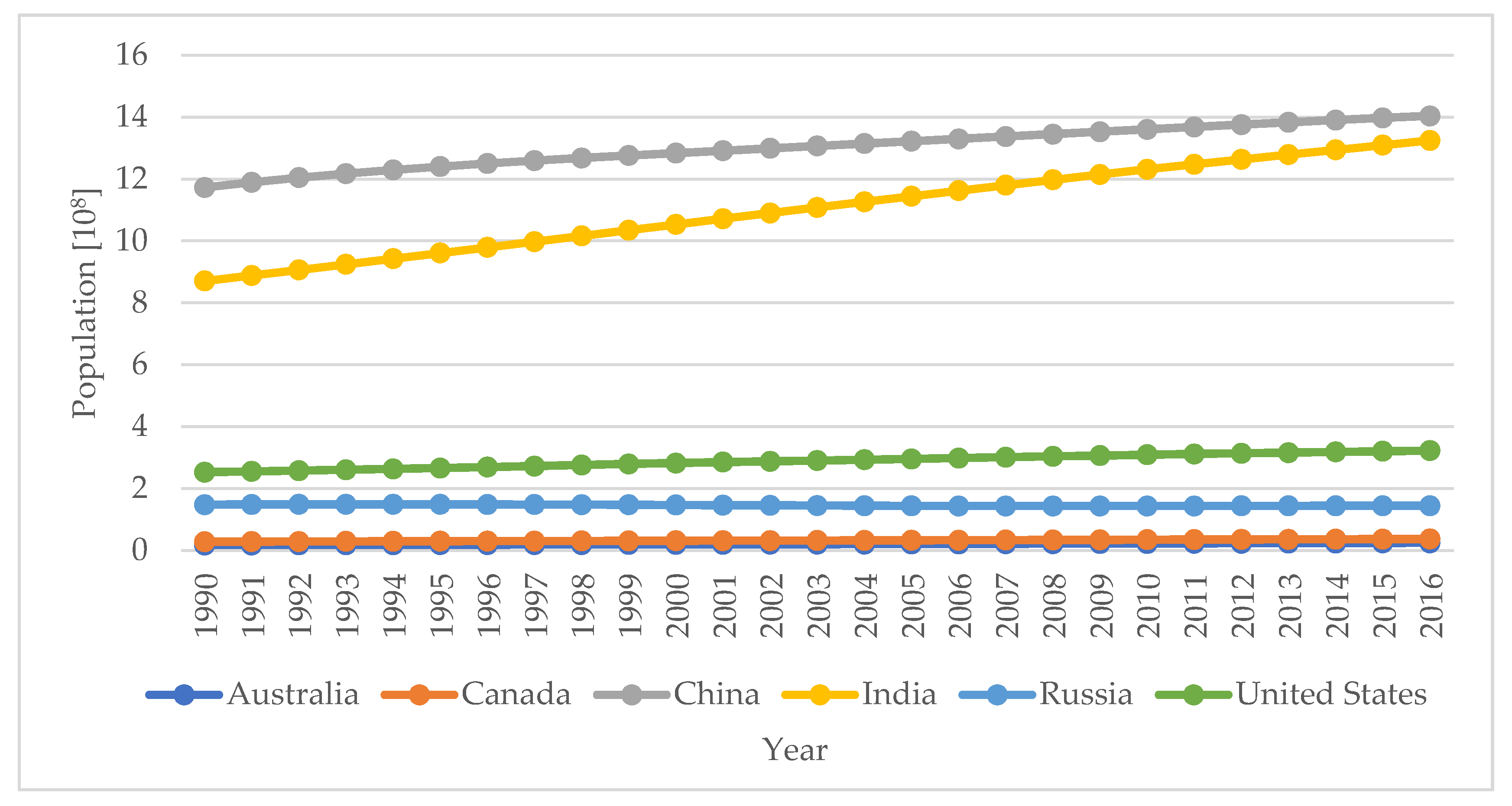

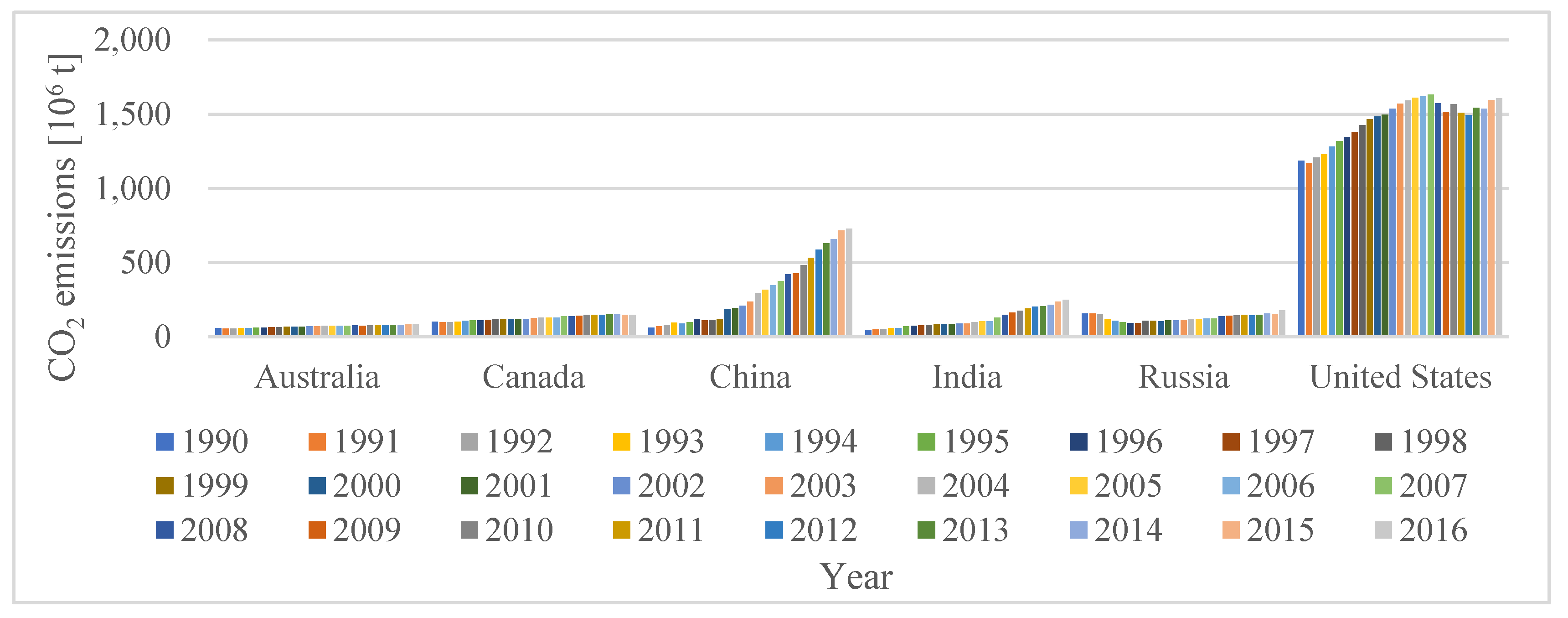

| Types of Energy | Conversion Factor (KJ/toe) | Carbon Oxidation Rate | CO2 Emission Factor (kgCO2/GJ) |
|---|---|---|---|
| Coal | 41,868 | 1 | 94.6 |
| Oil products | 41,868 | 1 | 72.35 |
| Biomass energy | 41,868 | 1 | 75.18 |
| Natural gas | 41,868 | 1 | 56.1 |
| Electric power | - | - | - |
| Elements | Description | Data Resource |
|---|---|---|
| GDP | Gross Domestic Production at constant 2010 prices in US Dollars | UN database |
| POP | Population | UN database |
| TRS | Total road turnover | World Bank database |
| PE | Total energy consumption of road transportation | IEA database |
| C | Total CO2 emissions of road transportation | Estimate by Formula (11) |
| Driving Factors | Description | Symbols |
|---|---|---|
| G | Economic output | G = GDP/POP |
| R | Transportation intensity | R = TRS/GDP |
| P | Energy intensity | P = PE/TRS |
| S | Carbon emissions coefficient | S = C/PE |
| O | Population size | O = POP |
| Country | Average Annual Growth Rate (%) | Carbon Emissions in 1990 (million tons) | Carbon Emissions in 2016 (million tons) | 1990–2016 Increasing Multiples of Carbon Emissions | Turning Points’ Year for Carbon Emissions | Per capita Carbon Emissions in 2016 (ton/person) |
|---|---|---|---|---|---|---|
| Australia | 1.46% | 56.68 | 82.29 | 0.45 | - | 3.41 |
| Canada | 1.49% | 100.36 | 146.60 | 0.46 | 2011 | 4.04 |
| China | 10.67% | 60.58 | 728.49 | 11.03 | - | 0.52 |
| India | 6.76% | 46.95 | 247.94 | 4.28 | - | 0.19 |
| Russia | 0.78% | 156.77 | 177.94 | 0.14 | - | 1.24 |
| United states | 1.20% | 1184.39 | 1606.24 | 0.36 | 2007 | 4.99 |
| Total | 22.36% | 1605.73 | 2989.51 | 16.71 | - | 14.38 |
| Australia | DG | DR | DP | DS | DO | ∆C | China | DG | DR | DP | DS | DO | ∆C |
| 1990–1992 | 1.01 | −4.00 | 0.72 | −0.01 | 1.45 | −0.82 | 1990–1992 | 13.51 | −7.16 | 9.97 | 0.02 | 1.84 | 18.18 |
| 1993–1995 | 3.14 | 1.83 | −3.01 | 0.00 | 1.28 | 3.36 | 1993–1995 | 19.84 | −7.37 | −11.22 | 0.01 | 1.77 | 3.47 |
| 1996–1998 | 4.58 | −2.27 | −1.48 | −0.01 | 1.35 | 2.24 | 1996–1998 | 17.26 | −7.41 | −17.50 | −0.01 | 1.60 | −5.29 |
| 1999–2001 | 2.45 | 0.41 | −3.92 | −0.03 | 1.40 | 0.34 | 1999–2001 | 22.58 | −8.45 | 62.81 | −0.01 | 1.83 | 79.73 |
| 2002–2004 | 3.32 | 1.14 | −2.29 | 0.00 | 1.71 | 3.70 | 2002–2004 | 44.58 | −12.40 | 46.61 | −0.59 | 2.91 | 82.39 |
| 2005–2007 | 2.84 | −0.27 | −3.61 | 0.01 | 2.53 | 0.54 | 2005–2007 | 83.42 | 3.20 | −33.09 | 0.33 | 3.95 | 59.15 |
| 2008–2010 | 0.66 | −4.49 | 2.87 | −0.01 | 2.71 | 0.65 | 2008–2010 | 81.02 | 37.72 | −63.60 | 0.03 | 5.12 | 61.41 |
| 2011–2013 | 1.74 | 0.00 | −2.72 | 0.00 | 2.34 | 0.71 | 2011–2013 | 80.71 | −46.93 | 58.87 | −1.18 | 6.46 | 98.94 |
| 2014–2016 | 1.62 | 0.02 | −1.74 | −0.02 | 2.22 | 1.60 | 2014–2016 | 84.51 | −42.65 | 23.44 | 0.34 | 6.63 | 74.19 |
| 1990–2016 | 31.96 | −4.03 | −26.15 | −0.03 | 23.88 | 25.62 | 1990–2016 | 606.64 | −146.15 | 161.82 | −2.71 | 48.31 | 667.91 |
| Canada | DG | DR | DP | DS | DO | ∆C | India | DG | DR | DP | DS | DO | ∆C |
| 1990–1992 | −3.72 | 9.17 | −9.42 | 0.00 | 2.46 | −1.51 | 1990–1992 | 0.83 | 15.02 | −11.80 | 0.00 | 2.02 | 6.06 |
| 1993–1995 | 5.16 | −0.15 | 0.02 | 0.00 | 2.24 | 7.50 | 1993–1995 | 6.69 | 5.30 | −1.68 | 0.00 | 2.42 | 12.79 |
| 1996–1998 | 6.97 | −4.14 | 1.11 | 0.01 | 2.11 | 6.50 | 1996–1998 | 4.98 | 5.31 | −7.70 | 0.00 | 2.86 | 5.61 |
| 1999–2001 | 5.91 | −5.46 | −3.28 | 0.07 | 2.22 | −0.21 | 1999–2001 | 4.69 | 5.16 | −11.32 | −0.12 | 2.98 | 1.69 |
| 2002–2004 | 3.53 | 22.70 | −21.42 | −0.01 | 2.47 | 7.33 | 2002–2004 | 11.86 | 1.89 | −7.15 | −0.10 | 3.06 | 10.06 |
| 2005–2007 | 3.16 | −7.48 | 11.97 | 0.05 | 2.97 | 10.26 | 2005–2007 | 13.86 | 11.39 | −4.63 | 0.04 | 3.51 | 24.98 |
| 2008–2010 | −3.17 | 5.26 | 1.96 | 0.04 | 3.23 | 6.74 | 2008–2010 | 20.77 | 16.61 | −12.92 | −0.20 | 4.47 | 30.23 |
| 2011–2013 | 3.16 | −0.19 | −2.69 | 0.02 | 3.06 | 3.01 | 2011–2013 | 17.88 | 13.51 | −24.44 | 4.26 | 4.92 | 18.45 |
| 2014–2016 | 0.73 | 4.57 | −10.73 | −0.02 | 2.82 | −2.62 | 2014–2016 | 28.67 | 18.78 | −20.26 | 0.02 | 5.36 | 35.49 |
| 1990–2016 | 38.91 | 31.02 | −56.80 | 0.13 | 32.99 | 46.25 | 1990–2016 | 140.19 | 157.71 | −146.96 | −0.66 | 50.72 | 200.99 |
| Russia | DG | DR | DP | DS | DO | ∆C | United States | DG | DR | DP | DS | DO | ∆C |
| 1990–1992 | −32.59 | 8.10 | 16.17 | −0.04 | 0.78 | −7.57 | 1990–1992 | 17.00 | 4.78 | −23.65 | 0.00 | 23.08 | 21.20 |
| 1993–1995 | −19.14 | −8.89 | 7.89 | 0.15 | −0.10 | −19.70 | 1993–1995 | 56.71 | 42.59 | −38.76 | 0.34 | 27.32 | 85.83 |
| 1996–1998 | −3.60 | −10.16 | 28.73 | −0.05 | −0.46 | 15.30 | 1996–1998 | 86.64 | −36.00 | −6.14 | 0.10 | 34.28 | 72.74 |
| 1999–2001 | 16.55 | −2.88 | −8.61 | 0.14 | −0.82 | 5.39 | 1999–2001 | 43.15 | −31.96 | −12.38 | −0.01 | 31.49 | 30.59 |
| 2002–2004 | 16.90 | −7.20 | 0.30 | 0.00 | −0.91 | 9.74 | 2002–2004 | 75.27 | −97.33 | 49.48 | 0.33 | 27.13 | 63.41 |
| 2005–2007 | 19.63 | −11.95 | −0.33 | −0.07 | −0.39 | 6.87 | 2005–2007 | 45.98 | −46.45 | −8.04 | 0.70 | 29.72 | 31.21 |
| 2008–2010 | −5.34 | −6.18 | 19.62 | 0.00 | 0.07 | 7.45 | 2008–2010 | −27.64 | −15.78 | 10.31 | 0.36 | 27.04 | 6.16 |
| 2011–2013 | 7.55 | 7.46 | −13.53 | 0.07 | 0.34 | 0.70 | 2011–2013 | 39.93 | −106.80 | 78.42 | 1.00 | 21.83 | 49.78 |
| 2014–2016 | −4.78 | −4.29 | 2.71 | −0.07 | 0.22 | −6.22 | 2014–2016 | 47.14 | −44.00 | 44.78 | 0.31 | 21.90 | 84.54 |
| 1990–2016 | 26.67 | −66.12 | 35.69 | 0.59 | −3.78 | -6.96 | 1990–2016 | 540.90 | −362.01 | −97.61 | 3.30 | 337.27 | 421.84 |
| Australia | BDG | BDR | BDP | BDS | BDO | BDC | China | BDG | BDR | BDP | BDS | BDO | BDC |
| 1990–1992 | −122.52 | 485.53 | −87.95 | 0.75 | −175.82 | 100 | 1990–1992 | 74.33 | −39.37 | 54.83 | 0.09 | 10.12 | 100 |
| 1993–1995 | 93.56 | 54.60 | −89.70 | 0.02 | 38.02 | 100 | 1993–1995 | 571.10 | −212.22 | −323.04 | 0.36 | 51.00 | 100 |
| 1996–1998 | 204.57 | −101.31 | −66.10 | −0.55 | 60.17 | 100 | 1996–1998 | −326.31 | 140.06 | 330.70 | 0.24 | −30.17 | 100 |
| 1999–2001 | 729.70 | 122.35 | −1169.14 | −10.11 | 416.27 | 100 | 1999–2001 | 28.32 | −10.59 | 78.77 | −0.01 | 2.29 | 100 |
| 2002–2004 | 89.81 | 30.75 | −61.91 | −0.09 | 46.24 | 100 | 2002–2004 | 54.11 | −15.06 | 56.57 | −0.71 | 3.53 | 100 |
| 2005–2007 | 525.30 | −50.31 | −667.91 | 2.03 | 467.42 | 100 | 2005–2007 | 141.03 | 5.41 | −55.95 | 0.56 | 6.67 | 100 |
| 2008–2010 | 101.61 | −687.50 | 439.48 | −0.87 | 415.45 | 100 | 2008–2010 | 131.92 | 61.41 | −103.56 | 0.04 | 8.34 | 100 |
| 2011–2013 | 245.41 | 0.66 | −383.39 | −0.70 | 329.49 | 100 | 2011–2013 | 81.57 | −47.43 | 59.50 | −1.19 | 6.52 | 100 |
| 2014–2016 | 101.12 | 1.09 | −108.66 | −1.48 | 139.00 | 100 | 2014–2016 | 113.91 | −57.49 | 31.60 | 0.46 | 8.94 | 100 |
| 1990–2016 | 124.76 | −15.74 | −102.10 | −0.14 | 93.22 | 100 | 1990–2016 | 90.83 | −21.88 | 24.23 | −0.41 | 7.23 | 100 |
| Canada | BDG | BDR | BDP | BDS | BDO | BDC | India | BDG | BDR | BDP | BDS | BDO | BDC |
| 1990–1992 | 245.81 | −605.44 | 622.05 | −0.13 | −162.29 | 100 | 1990–1992 | 13.67 | 247.88 | −194.86 | −0.01 | 33.30 | 100 |
| 1993–1995 | 68.76 | −1.94 | 0.28 | −0.02 | 29.89 | 100 | 1993–1995 | 52.27 | 41.46 | −13.16 | 0.00 | 18.89 | 100 |
| 1996–1998 | 107.34 | −63.70 | 17.12 | 0.15 | 32.51 | 100 | 1996–1998 | 88.88 | 94.73 | −137.35 | 0.01 | 51.01 | 100 |
| 1999–2001 | −2823.09 | 2606.35 | 1565.11 | −32.56 | −1058.92 | 100 | 1999–2001 | 276.95 | 304.54 | −667.93 | −7.23 | 175.75 | 100 |
| 2002–2004 | 48.15 | 309.83 | −292.37 | −0.08 | 33.70 | 100 | 2002–2004 | 117.91 | 18.82 | −71.09 | −1.02 | 30.37 | 100 |
| 2005–2007 | 30.83 | −72.95 | 116.69 | 0.47 | 28.91 | 100 | 2005–2007 | 55.48 | 45.58 | −18.53 | 0.15 | 14.07 | 100 |
| 2008–2010 | −47.01 | 78.05 | 29.02 | 0.54 | 47.92 | 100 | 2008–2010 | 68.70 | 54.94 | −42.72 | −0.67 | 14.80 | 100 |
| 2011–2013 | 104.77 | −6.21 | −89.25 | 0.54 | 101.48 | 100 | 2011–2013 | 96.92 | 73.22 | −132.46 | 23.06 | 26.65 | 100 |
| 2014–2016 | −27.90 | −174.25 | 409.06 | 0.67 | −107.58 | 100 | 2014–2016 | 80.77 | 52.91 | −57.10 | 0.06 | 15.09 | 100 |
| 1990–2016 | 84.14 | 67.07 | −122.83 | 0.29 | 71.34 | 100 | 1990–2016 | 69.75 | 78.47 | −73.12 | −0.33 | 25.23 | 100 |
| Russia | BDG | BDR | BDP | BDS | BDO | BDC | United States | BDG | BDR | BDP | BDS | BDO | BDC |
| 1990–1992 | 430.34 | −106.93 | −213.59 | 0.48 | −10.29 | 100 | 1990–1992 | 80.15 | 22.55 | −111.54 | 0.00 | 108.84 | 100 |
| 1993–1995 | 97.15 | 45.15 | −40.07 | −0.75 | 0.53 | 100 | 1993–1995 | 66.07 | 49.62 | −45.16 | 0.40 | 31.83 | 100 |
| 1996–1998 | −23.54 | −66.43 | 187.78 | −0.34 | −3.02 | 100 | 1996–1998 | 119.11 | −49.49 | −8.44 | 0.14 | 47.12 | 100 |
| 1999–2001 | 306.86 | −53.49 | −159.74 | 2.58 | −15.15 | 100 | 1999–2001 | 141.08 | −104.47 | −40.49 | −0.03 | 102.94 | 100 |
| 2002–2004 | 173.56 | −73.98 | 3.09 | 0.01 | −9.35 | 100 | 2002–2004 | 118.70 | −153.49 | 78.02 | 0.52 | 42.79 | 100 |
| 2005–2007 | 285.82 | −173.92 | −4.79 | −0.96 | −5.70 | 100 | 2005–2007 | 147.30 | −148.80 | −25.77 | 2.25 | 95.22 | 100 |
| 2008–2010 | −71.66 | −82.98 | 263.47 | 0.04 | 0.93 | 100 | 2008–2010 | −449.03 | −256.36 | 167.53 | 5.89 | 439.32 | 100 |
| 2011–2013 | 1085.39 | 1072.53 | −1945.79 | 9.77 | 49.18 | 100 | 2011–2013 | 80.20 | −214.52 | 157.53 | 2.02 | 43.85 | 100 |
| 2014–2016 | 76.92 | 68.91 | −43.51 | 1.15 | −3.47 | 100 | 2014–2016 | 55.77 | −52.05 | 52.97 | 0.37 | 25.91 | 100 |
| 1990–2016 | −383.12 | 950.05 | −512.81 | −8.49 | 54.38 | 100 | 1990–2016 | 128.22 | −85.81 | −23.14 | 0.78 | 79.95 | 100 |
© 2019 by the authors. Licensee MDPI, Basel, Switzerland. This article is an open access article distributed under the terms and conditions of the Creative Commons Attribution (CC BY) license (http://creativecommons.org/licenses/by/4.0/).
Share and Cite
Zhu, C.; Du, W. A Research on Driving Factors of Carbon Emissions of Road Transportation Industry in Six Asia-Pacific Countries Based on the LMDI Decomposition Method. Energies 2019, 12, 4152. https://doi.org/10.3390/en12214152
Zhu C, Du W. A Research on Driving Factors of Carbon Emissions of Road Transportation Industry in Six Asia-Pacific Countries Based on the LMDI Decomposition Method. Energies. 2019; 12(21):4152. https://doi.org/10.3390/en12214152
Chicago/Turabian StyleZhu, Changzheng, and Wenbo Du. 2019. "A Research on Driving Factors of Carbon Emissions of Road Transportation Industry in Six Asia-Pacific Countries Based on the LMDI Decomposition Method" Energies 12, no. 21: 4152. https://doi.org/10.3390/en12214152
APA StyleZhu, C., & Du, W. (2019). A Research on Driving Factors of Carbon Emissions of Road Transportation Industry in Six Asia-Pacific Countries Based on the LMDI Decomposition Method. Energies, 12(21), 4152. https://doi.org/10.3390/en12214152




